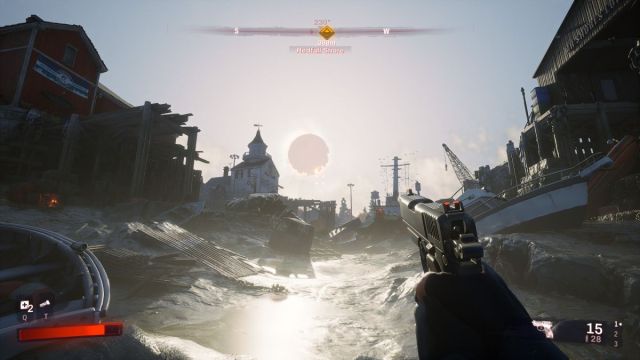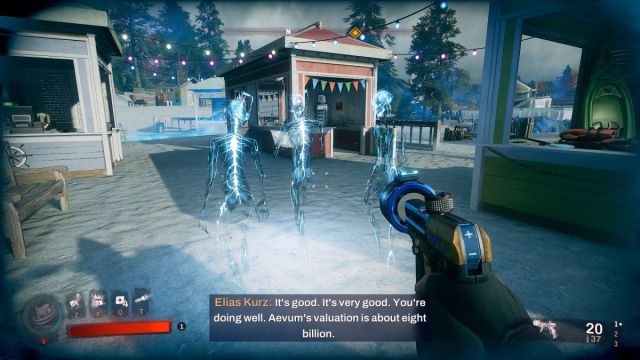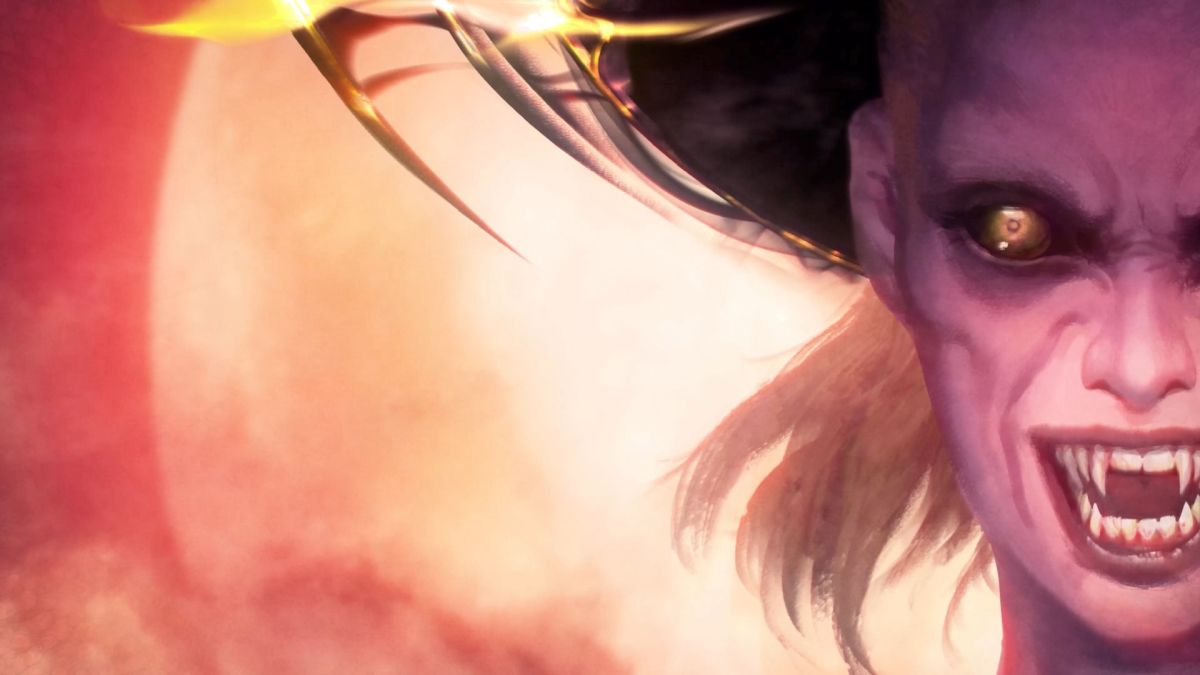It’s in the blood
With Redfall, I keep going back to the beginning. In my review-in-progress from the start of this week, I opened with the game’s introduction, because it paints quite the picture: a town overrun by vampires, some so powerful they can blot out the sun and freeze the oceans in place. It’s a good horror set-up: you are the livestock, penned into the town of Redfall, and you will either fight or be food.
It’s not too long after the introduction that I started to feel those drives fall by the wayside, though. There are pieces of Arkane Austin here, from immersive elements and storytelling to a generally interesting stylistic direction. But it all falters under the weight of bugs, repetition, locked-off doors, and a loop that didn’t do much for me.
Redfall (PC [Reviewed], Xbox Series X|S)
Developer: Arkane Austin
Publisher: Bethesda Softworks
Release: May 1, 2023
MSRP: $69.99 (also on Game Pass)
Arkane Austin’s Redfall is set in the titular town, which has been overrun by a cabal of vampires. There are both normal, blood-sucking vampires who can fly, rip, tear, and do short little teleports around the area. But your focus, as either a solo player or a crew, is on the small group of vampire ringleaders. They, along with their cultist followers and a private military hired to roll in and destroy corporate evidence of wrongdoing, are the primary villains and objectives you’ll be going after in each part of Redfall.
Vampire slayers for hire
To do this, you’ll need to pick a character and assemble the team. Redfall has some good character design, but in play, each one felt a bit lacking. Part of this problem is you get a decent amount of exposition through co-op, so I didn’t learn too much about my character playing solo; when the fog-spewing vampire Miss Whisper taunted my character Remi about never seeing her brothers again, that was the moment I learned she had brothers.

It’s possible I missed that story in the massive amount of text in Redfall, because there is a lot. Some of it is very good! A lot of it is also world-building, like a list of names for kitchen duty at the church or the same Aevum clinical trial pamphlet I’d seen a dozen times. Combine a bevy of text that could be important or mundane with a world that doesn’t pause for you, and most times I was just shoving paper into my character’s pocket and moving on. Which is a shame, because when the narrative clicks, I do think it has some interesting moments.
These are mostly in the main missions of Redfall, which will feel the closest to an immersive Arkane game. You’ll have an objective (which I frustratingly had to keep setting as a personal waypoint so I could see it on my HUD compass), and several potential avenues of approach. There’s a barn with intel on one of the vampire gods inside, defended by a sniper tower, turrets, and a ton of guards. Maybe you sneak in through an old bootlegger’s tunnel, or you take out the UV lights keeping the vampires out and take advantage of the ensuing chaos.
Routes and openings
Immersive sims are one thing, but games with multiple paths or options are what I often relate to Arkane. And there are hints of that here in Redfall. The aforementioned mission is just one case; in a church in the game’s second area, while knocking out a safehouse mission, I found a locked door that led to the attic, with environmental art making me wonder what could possibly be up there. But after turning the church over several times, I couldn’t find the key. As it turns out, I needed to accept a main mission later on in the story’s flowchart, which would then open the pathway to said key.
This felt indicative of a larger internal conflict of Redfall for me: while alternate pathways sometimes exist, other times and more often, you just need a key. A lot of Redfall, really, is going to a place, shooting vampires/cultists/PMC soldiers, picking up an objective, and returning to a safehouse for the next mission.

While the main missions provide some larger, more elaborate areas, the side and safehouse missions are where this repetition is really felt. Many of them involve going to a place and shooting something, whether it’s a weak point on a giant wicker effigy or special-class vampire, or even multiple waves of enemies while defending a location. None of these stood out in particular, even the side missions linked to the characters found around the hub areas for each major zone of Redfall. Shoot a vampire, pick up a skull or item, and return.
Really, Redfall feels mostly like a shooter, both in co-op and solo play. You can feasibly sneak around, but there are barely any options for stealth takedowns (or for vampires, stakedowns). Aside from the few times the story asked me to keep it quiet, Redfall was mostly a firefight.
Lock and load
So how is Redfall as a shooter? It’s got a decent number of guns, and many usual suspects. Some, like the shotgun and sniper rifle, feel good. Others, like handguns, felt a bit off. My favorite chunk of the arsenal was the vampire-specific weaponry. The flare gun is a neat addition, and the UV beam cannon adds an interesting weapon type. My absolute favorite, far and away, is the stake launcher. See, vampires can be put into a stunned state with normal bullets, but need to be fully done away with through petrification (through UV or sunlight), fire, or a stake to the heart.
The stake launcher says, “Why not launch the stakes into their heart?” And it really works. I love the power of it. The bulkiness of it. Racking stakes into the launcher port feels good, and even the little touches like the key on the body of the launcher add this DIY aspect that I love. Stakes offered an interesting dynamic; they’re incredibly powerful, often able to one-shot normal vampires, and quickly deal with heftier varieties. But it’s slow to reload, low in ammo capacity, and only really dispatches one enemy at a time.

Though I love the stake launcher, other guns don’t feel as compelling to me. An assault rifle is an assault rifle. Aside from its rate of fire or cosmetic upgrades, that gun type just goes up in damage over time. Most of the weapons, outside the gold tier, give you pretty numbers-based upgrades, like boosts to accuracy or reload speed. They don’t feel very compelling, when other loot-driven shooters frequently offer more interesting upgrades that visibly and tangibly affect how you play. Often in Redfall, I was just looking to see if the number went up, and scrapping the lesser.
Built for blood
This carries over into skills and levelling up, too. Some upgrades for each character’s abilities feel a bit meaningful, like adding an extra healing circle of Remi’s ultimate, centered around the robot dog Bribón. But other options in the tree include upgrading ammo capacity, a very boring upgrade, or an upgrade for reviving teammates, which did nothing for me in solo play. It felt like there was a whole third of the ability tree I purposefully ignored.
Skills, themselves, can also feel lackluster in single player. I personally gelled a lot with my chosen vampire slayer, Remi, and her tool set. But it’s a pretty straightforward set that, looping back to a previous section, doesn’t open up a lot of interesting traversal options. I feel like these abilities probably all shine better together in co-op, which I played a few hours of for this review but ducked out of after, since co-op story progress only goes towards the host’s file. There, skills could shine in concert with one another a bit more.
These tools also just feel unnecessary, as Redfall‘s shooter nature really just encourages taking out the enemy. Options for traversal, scouting, and other effects are nice, but I mostly just found myself in shootouts. And enemies died so fast (on the normal difficulty setting) that I rarely had time to set up some elaborate plan. Those plans often couldn’t predict the wackiness of Redfall, either.
Hitch in the system
It’s here I should probably talk a bit about the technical state of Redfall. It is, like many games released nowadays, in a state of flux. During the review process, I had a really tough time getting Redfall to run well on my PC. A day-one patch and driver update have since, at least somewhat, rectified that; I’m no longer on Low settings. I do still get very noticeable texture pop-ins and loading hitches.

Enemies glide across the ground, characters T-pose, stealth detection doesn’t always work leading to comical ring-around-the-rosie moments, and objects float in mid-air. At one point, my robot dog Bribón had completely disappeared from the game. As I was finishing Redfall for this review, objective markers for a completed mission were stuck on my screen. With live game development being the norm, I expect that months from now, many of these issues will be addressed. Some might be a bit more baked-in than others, but having already seen some technical tune-ups while reviewing, it feels like it’s trending that way.
I’m curious to see if post-launch updates and additions can bring something to this game, as they have to so many before it. But even in those situations, that means waiting on updates and hoping. And I’m also not sure if technical fixes alone will solve all of my hold-ups with Redfall.
A world of darkness
Despite all this, there are parts of Redfall I do enjoy. The stake launcher, for one. The general look and feel of this world is incredible, and reflects a lot of what I like about Arkane’s world-building in general. This coastal town has some great areas that look visually impressive, with psychic blasts tearing open the side of a house and twisting hallways bending through the creepy tunnels of a vampire nest. Little moments, like stepping through a movie theater screen into a new area, feel really great.
The classic vampire horror vibes are good. With long claws and menacing silhouettes, the undead ghouls are creepy, and small areas can still elicit tension as I round a corner or creep toward a cracked door. The story hits or misses for me, and I really wasn’t wild about the still-scene story moments; while some work, they don’t really match up to the feel of that original reveal trailer.

By the story’s end, I was left a bit ambivalent. I didn’t feel like I knew a ton about my chosen character, and while some of the moments were cool, Redfall‘s story doesn’t have many unforeseen twists or turns. Most of its interesting bits are in the lore, as you look around and find it during missions. Some of those can still impress, at the least.
Into the night
By the time the credits rolled, I felt myself weighing how out how I felt about Redfall. Bugs and qualms aside, it feels like a game that’s trying to do several interesting things, but misses on a lot of them. It’s a big bummer, as I really do like Arkane’s work, and I can see where the team had some really compelling ideas for a more action-driven game set in a world full of vampires.
As an immersive game, it falls short. And as a shooter, it’s too routine for me. There are better options out there, with more dynamic loot and discoverable environmental interactions. There are better boss fights than we see here. The open world doesn’t give me enough options, and too frequently, I found myself falling into a routine of running from waypoint to waypoint. I think Redfall is fine as a co-op game, maybe as something to pick up on Game Pass for Saturday night with pals. As a solo player, the tedium is much more palpable, and there’s not enough in the story to push me forward.
I really spent most of my time playing Redfall thinking about what else Redfall could have been. I like that Arkane tried something new, and I’m bummed it came out like this. It’s a really unique premise and concept in its first bite, but its fangs don’t leave a lasting mark.













Published: May 8, 2023 10:00 am